
North East England is one of nine official regions of England at the first level of ITL for statistical purposes. The region has three current administrative levels below the region level in the region: combined authority, unitary authority or metropolitan borough, and civil parishes. They are also multiple divisions without administrative functions; ceremonial county, emergency services, built-up areas and historic county. The most populous places in the region are Newcastle upon Tyne (city), Middlesbrough, Sunderland (city), Gateshead, Darlington and Hartlepool. Durham also has city status.

North Yorkshire is a ceremonial county in the North of England. It is mostly located in the Yorkshire and Humber region, but the area around the Tees Valley is in the North East. The largest county in England by land area, it measures 2,483 square miles (6,430 km2) and has a population of 1,158,816 (2021). The county town is Northallerton.

The North Riding of Yorkshire is a subdivision of Yorkshire, England, alongside York, the East Riding and West Riding. The riding's highest point is at Mickle Fell with 2,585 ft (788 metres).
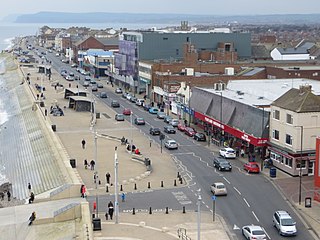
Redcar is a seaside town on the Yorkshire Coast in the Redcar and Cleveland unitary authority in the county of North Yorkshire, England. It is located 7 miles (11 km) east of Middlesbrough.

Teesside is a built-up area around the River Tees in the north of England, split between County Durham and North Yorkshire. The name was initially used as a county borough in the North Riding of Yorkshire.

County Durham, officially simply Durham, is a ceremonial county in North East England. The ceremonial county was created from the historic County Palatine of Durham in 1853.

BBC Radio Tees is the BBC's local radio station serving the former county of Cleveland which comprises the unitary authorities of Hartlepool, Middlesbrough, Redcar and Cleveland and Stockton-on-Tees.
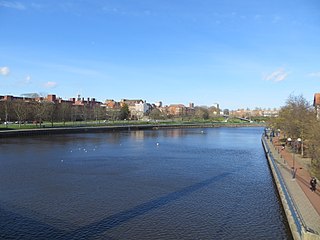
The Borough of Stockton-on-Tees is a unitary authority with borough status in the counties of County Durham and North Yorkshire, England. The borough had a population of 191,600 in 2011.

Tees Valley is a mayoral combined authority and Local enterprise partnership area in northern England, around the River Tees. The area is not a geographical valley.

Metropolitan and non-metropolitan counties are one of the four levels of subdivisions of England used for the purposes of local government outside Greater London and the Isles of Scilly. As originally constituted, the metropolitan and non-metropolitan counties each consisted of multiple districts, had a county council and were also the counties for the purposes of Lieutenancies. Later changes in legislation during the 1980s and 1990s have resulted in counties with no county council and 'unitary authority' counties with no districts. Counties for the purposes of Lieutenancies are now defined separately, based on the metropolitan and non-metropolitan counties.
Stockton-on-Tees Borough Council elections are held every four years. Stockton-on-Tees Borough Council is the local authority for the unitary authority of Stockton-on-Tees, which straddles the ceremonial counties of County Durham and North Yorkshire, England. Until 1 April 1996 it was a non-metropolitan district in Cleveland.
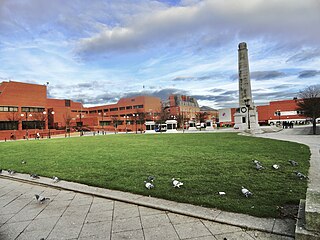
The Borough of Hartlepool is a unitary authority area in ceremonial County Durham, England. The borough's largest town is Hartlepool.

Middlesbrough Council, formerly known as Middlesbrough Borough Council, is a unitary authority based in Middlesbrough in North Yorkshire, England. The authority has combined some duties with its nearby councils to form the Tees Valley Combined Authority. The borough is often considered to be larger than current borough boundaries, with a total built-up population of 174,700. It is in the statistical region of North East England.
Hartlepool Borough Council elections usually take place for a third of the council, three years out of every four. Hartlepool Borough Council is the local authority for the unitary authority of Hartlepool in County Durham, England. Until 1 April 1996 it was a non-metropolitan district in Cleveland. Between 2002 and 2013 the council was led by a directly elected mayor.
Sedgefield Borough Council elections were generally held every four years between the council's creation in 1974 and its abolition in 2009. Sedgefield was a non-metropolitan district in County Durham, England. On 1 April 2009 the council's functions passed to Durham County Council, which became a unitary authority.

Cleveland was a ceremonial county located in northern England. It was created in 1974 under the Local Government Act 1972, and named after the historic area of Cleveland, Yorkshire. The county was abolished in 1996. The area was partitioned between the four boroughs of Hartlepool, Stockton-on-Tees, Middlesbrough and Langbaurgh-on-Tees, the latter of which took its name from the former Langbaurgh East. The county town was Middlesbrough. The administrative county bordered County Durham to the north and North Yorkshire to the south, and it faced the North Sea to the east. Cleveland had a total area of 225 square miles (583 km2). The legacy of the county lives on in some public bodies, such as Cleveland Police.
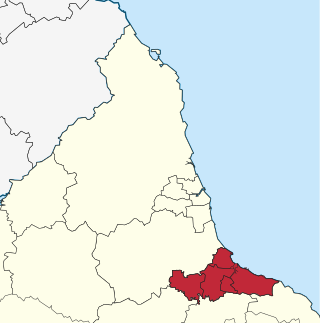
The Tees Valley Combined Authority (TVCA) is the combined authority for the Tees Valley urban area in England consisting of the following five unitary authorities: Darlington, Hartlepool, Middlesbrough, Redcar and Cleveland, and Stockton-on-Tees, covering a population of approximately 700,000 people. It was proposed that a combined authority be established by statutory instrument under the Local Democracy, Economic Development and Construction Act 2009. It is a strategic authority with powers over transport, economic development and regeneration including the flagship Teesside Freeport.
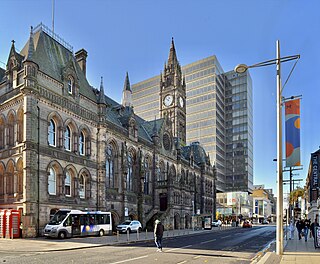
The Borough of Middlesbrough is a borough with unitary authority status in North Yorkshire, England, based around the town of Middlesbrough in the north of the county. It is in the Tees Valley mayoralty along with Stockton-on-Tees, Redcar and Cleveland, Hartlepool and Darlington boroughs. Nunthorpe along with Stainton and Thornton have statutory parish councils.
The non-metropolitan county of Cleveland was created under the Local Government Act 1972, which came into effect on 1 April 1974, comprising the urban areas around the mouth of the River Tees, previously parts of the administrative counties of Durham and North Riding of Yorkshire. Although it was abolished in 1996, the four unitary authorities which succeeded it have been considered together for the purposes of reviewing parliamentary boundaries. The area has returned 6 MPs to the UK Parliament since 1983.
















